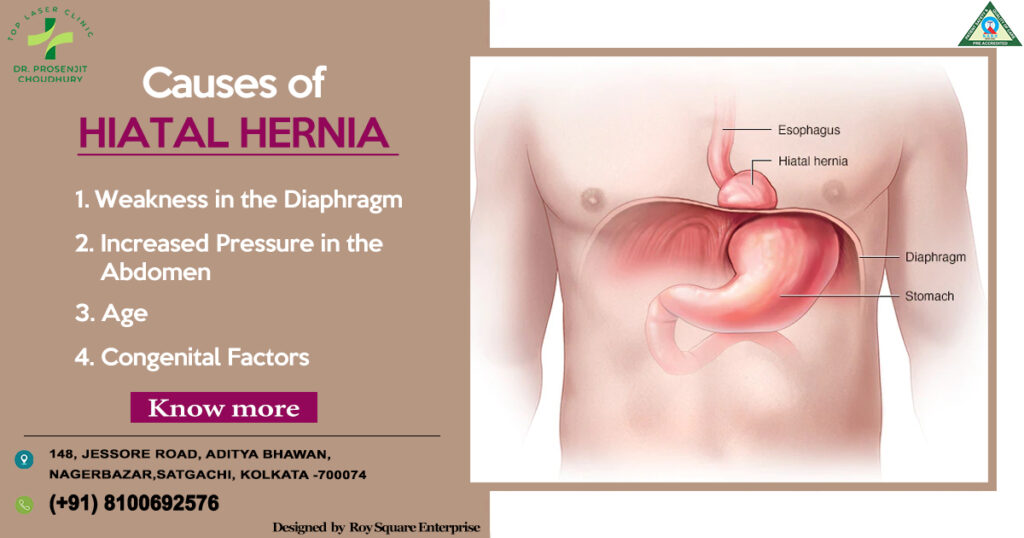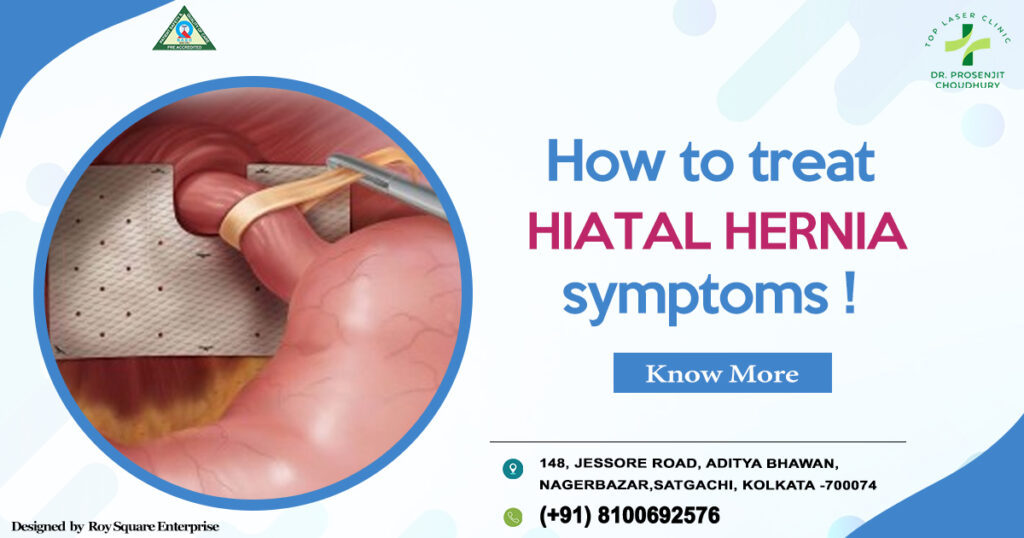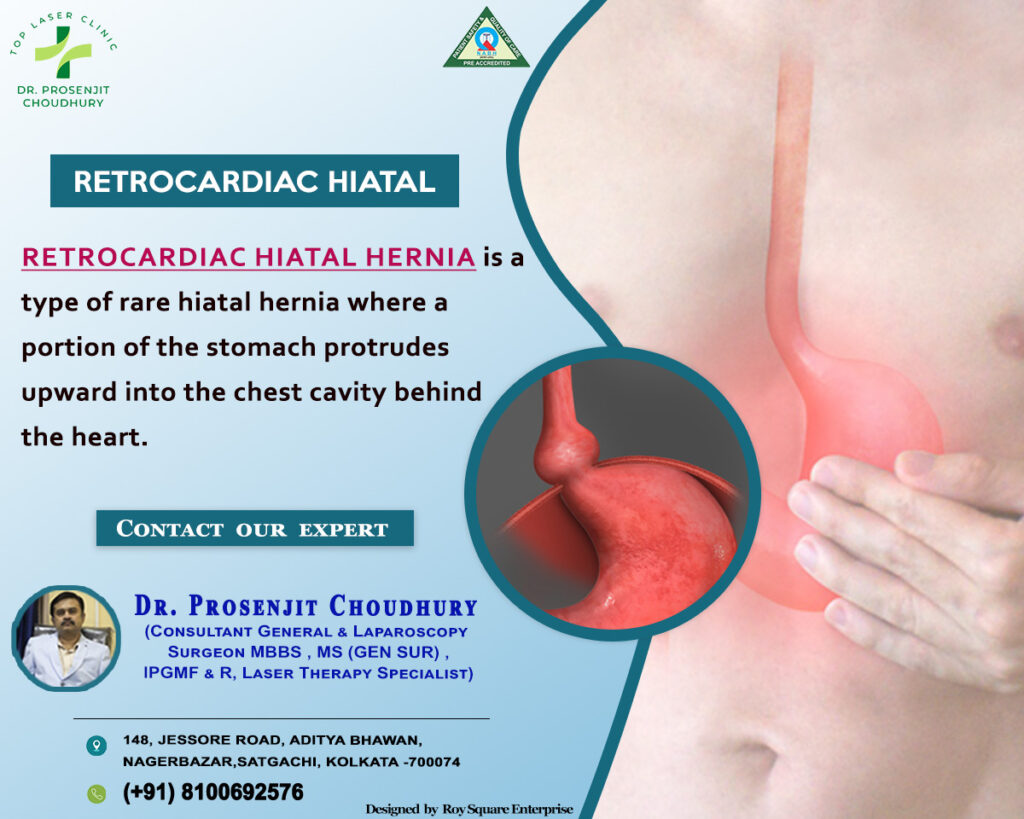Table of Contents
Hiatal Hernia
Hiatal hernia is a medical disorder that happens when a portion of the stomach protrudes upward into the chest opening through an opening in the diaphragm called the hiatus. While it can be asymptomatic for some individuals, it may cause discomfort and complications for others. Understanding the causes and symptoms of hiatal hernia is essential for proper diagnosis and management.
Causes of Hiatal Hernia:

1.Weakness in the Diaphragm: The diaphragm is a muscle that separates the chest cavity from the abdomen. A weakness or an opening in this muscle can allow the stomach to bulge through, leading to a hiatal hernia.
2.Increased Pressure in the Abdomen: Factors such as obesity, pregnancy, coughing, straining during bowel movements, or lifting heavy objects can increase pressure within the abdominal cavity. This heightened pressure can push the stomach upward through the diaphragm.
3.Age: As people age, the muscles supporting the diaphragm may weaken, making older adults more prone to developing hiatal hernias.
4.Congenital Factors: Some individuals may be born with an unusually large hiatus, making them more susceptible to hiatal hernias.
Symptoms of Hiatal Hernia:
1.Heartburn: One of the most common symptoms of hiatal hernia is heartburn, a burning sensation in the chest caused by stomach acid refluxing into the esophagus. This symptom often worsens when lying down or bending over.
2.Difficulty Swallowing (Dysphagia): A hiatal hernia can narrow the esophagus, making it difficult to swallow solid foods. This sensation might feel like food is stuck in the throat.
3.Chest Pain: Some individuals with hiatal hernias may experience chest pain that can mimic symptoms of a heart attack. This discomfort may occur after eating or when lying down.
4.Regurgitation: Regurgitation involves the backflow of stomach contents into the throat or mouth, often accompanied by a sour or bitter taste.
5.Belching or Hiccups: Hiatal hernias can contribute to increased belching or persistent hiccups due to the stomach’s proximity to the diaphragm.
6.Fatigue: Chronic irritation of the esophagus caused by acid reflux associated with hiatal hernias can lead to poor sleep quality, resulting in fatigue and daytime sleepiness.
Hiatal hernias can vary in severity and may not always cause noticeable symptoms. However, if symptoms such as persistent heartburn, difficulty swallowing, or chest pain occur, it is essential to seek medical evaluation. Treatment options for hiatal hernias range from lifestyle changes and medications to surgical intervention in severe cases. Early diagnosis and management can help alleviate symptoms and prevent complications associated with this condition. If you suspect you have a hiatal hernia or are experiencing related symptoms, consult with a healthcare professional for proper evaluation and personalized treatment recommendations.
How to treat hiatal hernia symptoms

Treatment for hiatal hernia symptoms typically involves a combination of lifestyle modifications, medications, and, in some cases, surgical intervention. Here are some common approaches to managing hiatal hernia symptoms:
1. Lifestyle Changes:
•Dietary Modifications: Avoiding foods and beverages that can trigger acid reflux, such as spicy foods, citrus fruits, caffeine, alcohol, and carbonated drinks, can help alleviate symptoms. Eating smaller, more frequent meals and avoiding large meals close to bedtime can also reduce the likelihood of reflux.
•Weight Management: Losing excess weight, if overweight or obese, can help reduce pressure on the abdomen and decrease symptoms of hiatal hernia.
•Posture and Body Mechanics: Maintaining good posture, avoiding tight clothing around the waist, and practicing proper body mechanics (e.g., lifting with the legs instead of the back) can help minimize intra-abdominal pressure and reduce hernia symptoms.
2. Medications:
•Antacids: Over-the-counter antacids, such as Tums or Rolaids, can provide temporary relief from heartburn and acid reflux symptoms by neutralizing stomach acid.
•Proton Pump Inhibitors (PPIs): Prescription or over-the-counter PPIs, such as omeprazole (Prilosec), lansoprazole (Prevacid), or esomeprazole (Nexium), help reduce the production of stomach acid and promote healing of the esophagus.
•H2 Receptor Blockers: Medications like ranitidine (Zantac) or famotidine (Pepcid) can reduce the production of stomach acid and provide relief from heartburn symptoms.
3. Elevating the Head of the Bed:
Sleeping with the head of the bed elevated can help prevent stomach acid from refluxing into the esophagus during sleep. This can be achieved by placing blocks under the bed frame or using a wedge-shaped pillow.
4. Avoiding Triggering Factors:
Identifying and avoiding factors that exacerbate hiatal hernia symptoms, such as smoking, certain medications (e.g., NSAIDs), and stress, can help manage symptoms effectively.
5. Surgery:
In cases where lifestyle modifications and medications fail to provide adequate relief or if complications like severe reflux, bleeding, or strangulation of the hernia occur, surgical intervention may be necessary. Surgical procedures for hiatal hernia repair include laparoscopic Nissen fundoplication, in which the stomach is wrapped around the lower esophagus to reinforce the lower esophageal sphincter, or hernia repair with mesh reinforcement.
It is vital for individuals with hiatal hernias to work closely with their healthcare providers to develop a comprehensive treatment plan tailored to their specific needs and symptoms. Regular follow-up visits and adjustments to the treatment plan may be necessary to ensure optimal management of hiatal hernia symptoms and prevention of complications.
Different types of hiatal hernia
There are primarily two main types of hiatal hernias: sliding hiatal hernias and paraesophageal (or rolling) hiatal hernias. Here is a quick synopsis of each kind:
1. Sliding Hiatal Hernia:
• Sliding hiatal hernias are the most common type, accounting for approximately 95% of all hiatal hernias.
• In a sliding hiatal hernia, the gastroesophageal junction and a portion of the stomach slide up into the chest through the esophageal hiatus (an opening in the diaphragm).
• This type of hernia is usually small and tends to move in and out of the chest cavity, particularly during swallowing.
• Sliding hiatal hernias are often associated with gastroesophageal reflux disease (GERD) and can lead to symptoms such as heartburn, regurgitation, and difficulty swallowing.
2. Paraesophageal (Rolling) Hiatal Hernia:
• Paraesophageal hiatal hernias are less common but can be more serious than sliding hiatal hernias.
• In a paraesophageal hiatal hernia, a portion of the stomach protrudes through the esophageal hiatus and sits next to the esophagus, rather than sliding into the chest.
• Unlike sliding hiatal hernias, paraesophageal hernias are less likely to move in and out of the chest cavity and may remain in a fixed position.
• Paraesophageal hiatal hernias can potentially lead to complications such as gastric volvulus (twisting of the stomach), obstruction of the stomach or esophagus, or strangulation of the herniated tissue.
• Symptoms of paraesophageal hiatal hernias may include severe chest pain, difficulty swallowing, feeling full quickly, and nausea.
These are the two main types of hiatal hernias, but there can also be variations and combinations of these types. The size and severity of a hiatal hernia can vary among individuals, and some people may have no symptoms at all. However, if symptoms are present or if complications arise, medical evaluation and treatment may be necessary. Treatment options may include lifestyle modifications, medications, or surgical intervention, depending on the severity of symptoms and the presence of complications.
Retrocardiac hiatal hernia

Retrocardiac hiatal hernia is a type of rare hiatal hernia where a portion of the stomach protrudes upward into the chest cavity behind the heart. Symptoms of retrocardiac hiatal hernia can vary depending on the size of the hernia and the extent of tissue displacement. Some common symptoms include:
1.Heartburn: Retrocardiac hiatal hernia can lead to gastroesophageal reflux disease (GERD), causing a burning sensation in the chest or throat known as heartburn. This symptom often worsens after meals or when lying down.
2.Difficulty Swallowing (Dysphagia): When the herniated portion of the stomach compresses the esophagus, it can lead to difficulty swallowing, especially with solid foods.
3.Chest Pain: Patients may experience chest pain or discomfort that can mimic symptoms of a heart attack. This pain may radiate to the back or shoulder blades and may worsen with eating or lying down.
4.Regurgitation: Retrocardiac hiatal hernia can cause stomach contents, including acid, to reflux back into the esophagus, leading to regurgitation. This may be accompanied by a sour or bitter taste in the mouth.
5.Shortness of Breath: In some cases, large hiatal hernias can compress the lungs or the heart, leading to difficulty breathing, especially when lying flat or during physical exertion.
6.Fatigue: Chronic reflux and disrupted sleep due to symptoms such as heartburn and coughing can lead to fatigue and daytime sleepiness.
7.Coughing or Wheezing: Irritation of the esophagus and airways caused by acid reflux can trigger coughing or wheezing, particularly at night or after meals.
8.Anemia: Chronic bleeding from erosive esophagitis, a complication of severe GERD associated with hiatal hernia, can lead to iron deficiency anemia.
It is significant to note that some individuals with retrocardiac hiatal hernia may remain asymptomatic or have mild symptoms that do not significantly impact their quality of life. However, if symptoms are persistent, severe, or accompanied by signs of complications such as gastrointestinal bleeding or difficulty swallowing, medical evaluation is warranted.
Treatment for retrocardiac hiatal hernia focuses on managing symptoms and preventing complications. This may include lifestyle modifications, such as dietary changes, weight management, and elevating the head of the bed, as well as medications to reduce acid reflux. In cases of severe or refractory symptoms, surgical intervention may be necessary to repair the hernia and reinforce the lower esophageal sphincter. Individuals experiencing symptoms suggestive of retrocardiac hiatal hernia should consult with a healthcare professional for proper evaluation and management.